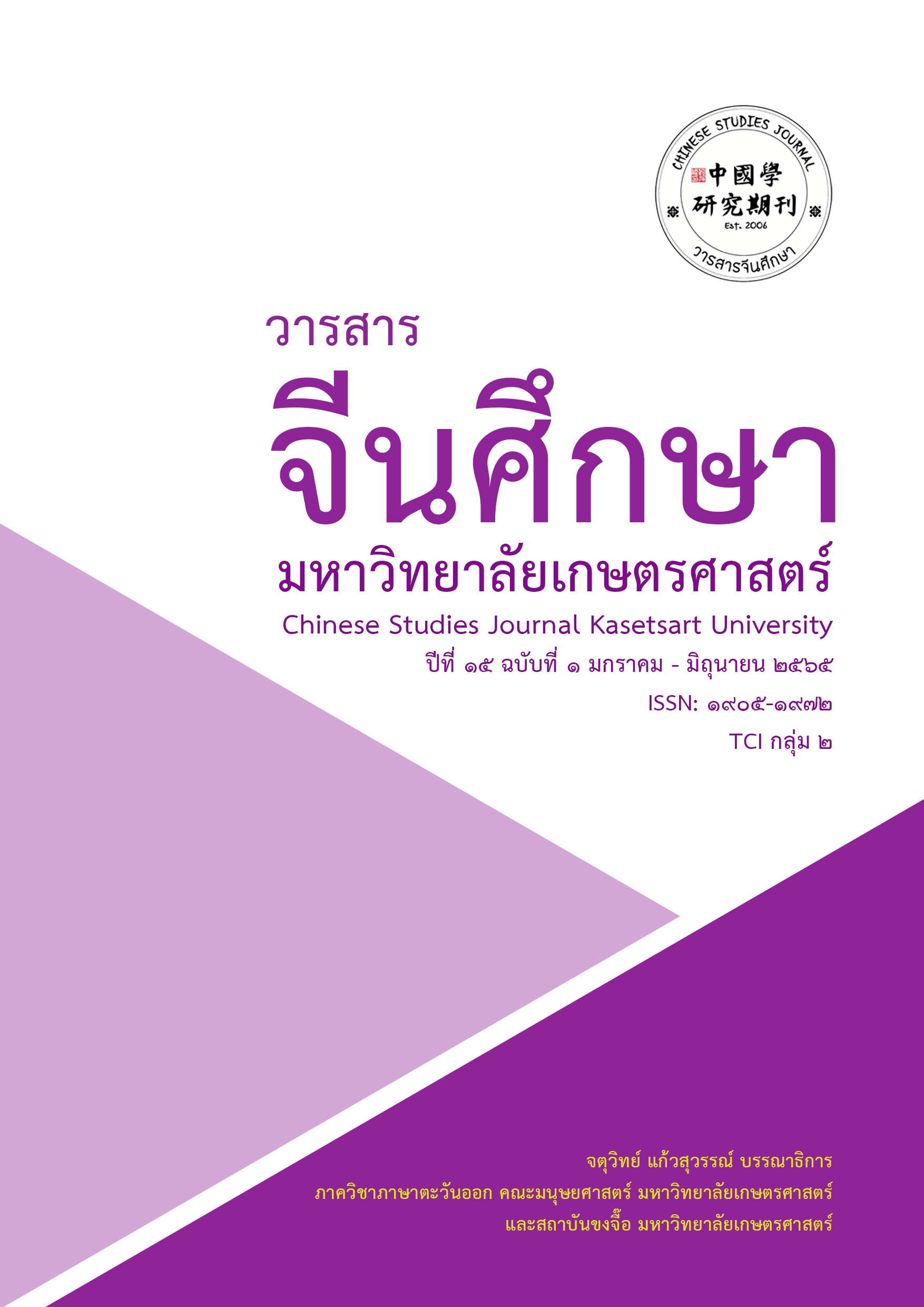a A Study on the Conceptual Metaphor of “Cattle” in Chinese and Thai Languages from a Cognitive Perspective การศึกษาอุปมาอุปไมยเชิงมโนทัศน์ของ “วัว/ควาย” ในภาษาจีนและภาษาไทยจากมุมมองทางปัญญา
Main Article Content
Abstract
Humans and animals are inextricably linked. In coexistence between humans and animals, people are increasingly familiar with animal’s morphological characteristics, living habits and various values, and constantly endow various animals with specific cultural symbolic meanings. These cultural symbolic experiences have been thoughtfully processed to the level of language, thus forming unique animal metaphors. Animal metaphors in both Chinese and Thai languages are very systematic. This paper selects “Cattle”, the animal which is well known by Chinese and Thai people, as the starting point of the research. Based on the conceptual metaphor theory of cognitive linguistics, and on the basis of full explaining the cultural meaning of “Cattle”, this paper deeply explores and analyzes the conceptual metaphor mode of “Cattle” in Chinese and Thai languages, and studies the generation mechanism of its meaning. Due to the influence of natural environment, national culture, religious customs and thinking habits, the conceptual metaphor of “Cattle” in Chinese and Thai languages presents its own characteristics on the basis of highlighting the huge shape, dumb and slow movements of the cattle.
Article Details

This work is licensed under a Creative Commons Attribution-NonCommercial-NoDerivatives 4.0 International License.
ผลงานทางวิชาการที่ลงตีพิมพ์ในวารสารจีนศึกษา มหาวิทยาลัยเกษตรศาสตร์ เป็นลิขสิทธิ์ของผู้เขียนหรือผู้แปลผลงานนั้น หากนำลงในวารสารจีนศึกษาเป็นครั้งแรก เจ้าของผลงานสามารถนำไปตีพิมพ์ซ้ำในวารสารหรือหนังสืออื่นได้โดยมิต้องแจ้งให้ทราบล่วงหน้า แต่หากผลงานที่ได้รับพิจารณานำลงในวารสารจีนศึกษา เป็นผลงานที่เคยตีพิมพ์ที่อื่นมาก่อนเจ้าของผลงานต้องจัดการเรื่องปัญหาลิขสิทธิ์กับแหล่งพิมพ์แรกเอง หากเกิดปัญหาทางกฎหมาย ถือว่าไม่อยู่ในความรับผิดชอบของวารสารจีนศึกษา มหาวิทยาลัยเกษตรศาสตร์ ทั้งนี้ ความคิดเห็นต่างๆ ในบทความเป็นความคิดเห็นส่วนตัวของผู้เขียน ไม่เกี่ยวกับกองบรรณาธิการวารสารจีนศึกษา มหาวิทยาลัยเกษตรศาสตร์
References
Ivor Armstrong Richards. (1965). The Philosophy of rhetoric. New York: Oxford University Press.
Jindarat Bunphan. (2004). The Metaphorical meanings to animals in Thai Idioms. Bangkok: Thammasat University.
Jirapron Pattrapanupat. (1968). Thai idioms. Bangkok: Thai Press.
Piriya Surakajoh. (2001). Chinese and Thai Idiomatic Expressions As Related to Animals. Bangkok: Chulalongkorn University.
Rangsima Rungrueng. (2007). “When “Human” Becomes “Animal”: Figurative meanings of “Animal” in Thai and Indonesian.” Journal of Language and Linguistics, 35(2).
Yonlin Qin. (1983). Chinese and Thai idiomatic expressions: A comparative study. Bangkok: Chulalongkorn University.
安继民译注.(2010).荀子.河南:中州古籍出版社。
巴尔扎克著,韩沪麟译.(2014).幽谷百合.南昌:百花洲文艺出版社。
白先勇.(2013).台北人.南宁:广西师范大学出版社。
毕淑敏.(2017).同你现在一般大.北京:新星出版社。
毕淑敏.(2017).女人之约.北京:新星出版社。
陈晦.(2011).英汉植物词语对比研究.上海:上海外国语大学。
陈忠实.(2008).第一刀.北京:北京十月文艺出版社。
村上春树著,林少华译.(2018).世界尽头与冷酷仙境.上海:上海译文 出版社。
佛弟子文库.(2014).牛头马面的来历与职责.检索时间2020-04-08, 来自 http://www.fodizi.net/fojiaozhishi/13677.html.
冯骥才.(2021).神鞭.北京:作家出版社。
福楼拜著,郑永慧译.(2003).萨朗波.南京:译林出版社。
告达君·素帕.(2006).汉泰动物成语比较研究.天津:天津师范大学。
格非.(2019).江南三部曲.北京:北京十月文艺出版社。
郭丹、程小青、李彬源译注.(2012).左传.北京:中华书局。
何善芬.英汉语言对比研究.(2002).上海:上海外国语出版社。
胡平生,张萌译注.(2017).礼记.北京:中华书局。
老舍.(2020).四世同堂.北京:旅游教育出版社。
李创鑫.(2001).汉泰成语与自然环境.修辞学习。
李福印.(2008).认知语言学概论.北京:北京大学出版社。
李智文.(2014).汉泰动物成语对比分析及其文化差异.南宁:广西大学。
陆玖译注.(2011).吕氏春秋.北京:中华书局。
马非百.(1982).秦集史.北京:中华书局。
莫言.(2004).牛.北京:民族出版社。
束定芳.(2000).隐喻学研究.上海:上海外语教育出版社。
司马中原.(2011).狂风沙.南京:译林出版社。
(宋)陈彭年.(2008).宋本广韵.南京:江苏教育出版社。
孙永斌.(2008).汉泰动物成语的对比分析.厦门:厦门大学。
王火.(2019).战争和人.北京:人民文学出版社。
王文斌.(2006).再论隐喻中的相似性.四川外国语学院学报,(2):125-130。
王小波.(2018).黑铁时代.北京:北京十月文艺出版社。
王旭烽.(2019).茶人三部曲.北京:人民文学出版社。
王寅.(2007).认知语言学.上海:上海外语教育出版社。
徐正英,常佩雨译注.(2014).周礼.北京:中华书局。(魏)曹丕.(1998).列异传等五种.北京:文化艺术出版社。
杨绛.(2009).杨绛文集散文卷(上)—干校六记丙午丁未年纪事将饮茶杂忆与杂写.北京:人民文学出版社。
张恨水.(2018).夜深沉.合肥:安徽文艺出版社。
张倩霞.(2008).泰汉语言中关于动物成语的比较考察.绵阳师范学院学报。
中华人民共和国商务部.(2010).泰国.检索时间:2022-03-15来自 http://www.mofcom.gov.cn/aarticle/Nocategory/201010/2010100719717 0.html


